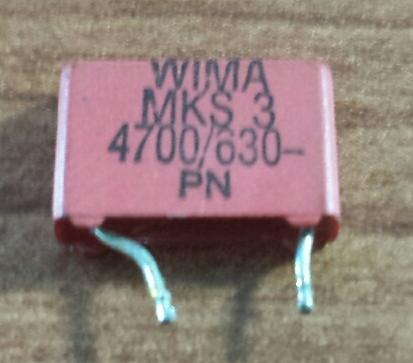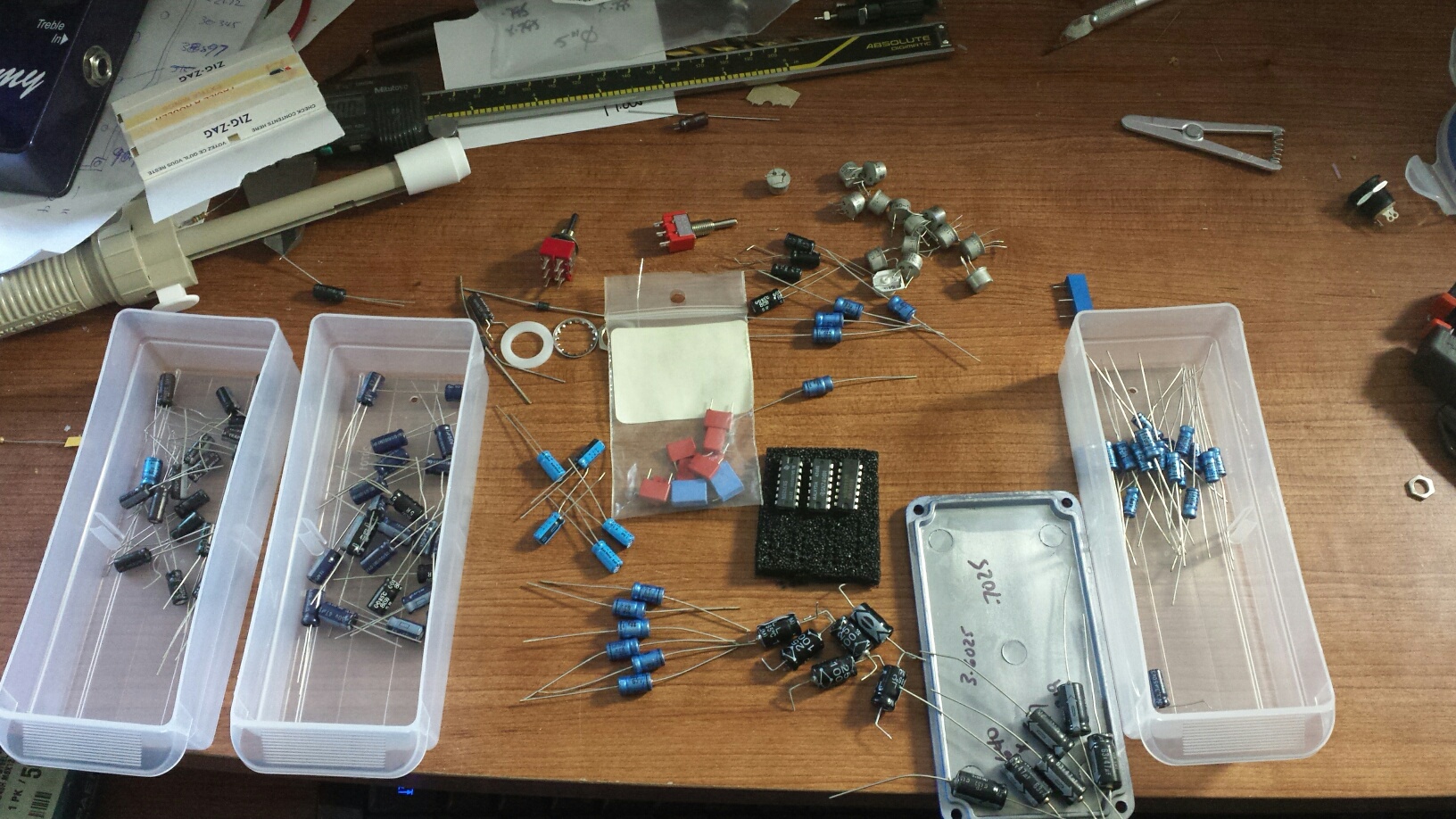My first board sans the wiring
12









12
Re: My first board sans the wiring
|
My work use to have an apprenticeship program for all 3 trades. But one dy they shut it down. For some reason our building was chosen to take all the stuff when the school closed down. We have absolutley no use for anything in this cupboard. So I can take anything in there I want. There is huge selection of resistors, caps diodes veroboard etc.. I'm not too worried about getting everything to exact spec. Especially some of the vintage projects i am working on. If its a carbon resisotr I'm ok with that. I may go back and swap out the questionable stuff at a later date, but for now I'm just having fun making stuff
|
|
In reply to this post by knight_yyz
 binoculars on? sorry, this image is massive but it's worth printing out and sticking on your workshop wall until you get used to things. milo made the diagram (mark and milo created this site). it's from the offboard wiring section here: http://tagboardeffects.blogspot.co.uk/2012/02/offboard-wiring.html basically, taking the 3pdt as an example (3 pole, double throw), 'throwing' the three pole switch up will join the middle row to the top row (2 to 1, 5 to 4, 8 to 7) and 'throwing' it the other will join the middle row to the bottom row (2 to 3, 5 to 6, 8 to 9). stomping on the switch does the 'throwing' of the mechanism inside to achieve this. to test you r switch, take 9v battery+ to led+ and led- to 1k resistor to pole 2 of the stomp. then take a ground lead from pole 1 to the - of the 9v battery. if the led lights up, stomp and it shoud go out. if the led isn't lit, stomp and it should go on. repeat across all poles as necessary, middle up or middle down. in my limited experience 3pdt switches are pretty robust re soldering etc, but i once bought a sub-mini 2pdt switch which was made of cheese i think. as soon as i put the soldering iron to it the lug sunk into the switch. rubbish. |
Re: My first board sans the wiring
|
Also = one funny thing bout switch wiring is that each row starts at the top
1 4 7 1_4 2 5 8 2_5 3 6 9 3_6 But with an IC chip (TL082) - the lug numbers go around the piece counter-clockwise 1 _ 8 2 _ 7 3 _ 6 4 _ 5 Just more of the crazy stuff you have to remember. It is a really good idea to get used to using your DMM functions: especially simple "continuity" (hopefully with a beeper, it is definitely a must-have function for any DMM you buy). I always test my toggle switches after I wire them because (as stated) they are way too sensitive to heat and they will break and not make internal connections if you solder any lug for too long. I have replaced many. I also always triple-check my pots wiring, because when you mount them in a box and suddenly look at them from the bottom, then #1 appears to be on the opposite side (right instead of left). For a long time I would mark the lug numbers. |
Re: My first board sans the wiring
|
My "workbench" is my computer bench. so if I need any info I just pull out the keyboard and google. LOL. I do have a pile of documents stored in my Music folder. Although that is not what Microsoft intended when they thought of that. LOL
|
Re: My first board sans the wiring
|
In reply to this post by knight_yyz
http://www.stewmac.com/freeinfo/i-1611/1611_dia5.gif |
Re: My first board sans the wiring
|
Hey guys, I have the 1unf cap in the board. I almost missed it because it is almost the same colour as the board in the diagram. What type of cap is the very looking for with that orange yellow football shape? I've Ben using the box style for the red footballs and electrolytic for the directional Ines. Is that tantalum or the little brown saucer style?
|
Re: My first board sans the wiring
|
Okay - usually that shape is to represent "ceramic" caps - which is one way of making caps under 1uF. In other words, not a polarized electrolytic. So, that is (probably) a 1nf cap (not a 1 uF) - although I can't see your schematic so I am not sure.
Most of us tend to use Panasonic (square orange caps) or "box" caps for non-polarized caps (I suggest you Google "types of capacitors). But if all you have is ceramic, especially a value that small (1nf) that is perfectly fine. I also suggest you download Electronics Assistant V4.31 (free) - it helps you identify the number code for different value caps. 1nf is a "102" cap (that is what it will have stamped on it). It comes in ceramic, Panasonic film, or box (also film). |
Re: My first board sans the wiring
|
This schematic has 2 different 10nf caps.
 There is a red football shape and a yellowish footbal shape. For the red one's I use something like this  For the yellow football I used one of this style in 10n  But, if i didn't have the shitty ceramic ones, what would happen if I out an electrolytic or one of the box styles in it's place. I've also seen green footballs on other schematics. Why is there no legend for these icons? Can't google yellow footbal veroboard.... LOL |
Re: My first board sans the wiring
|
It doesn't matter. The value is the important thing here. A 10nF cap is a 10nF cap whether it's ceramic or film or mica or whatever. Use what you've got. The different legends are because of the different spans of those two caps. The red Panasonic ones and other similar caps span 3 rows without bending leads while certain ceramic caps only span two this way (or are at least less bulky when bent to accommodate the spacing).
Through all the worry and pain we move on
|
|
This post was updated on .
In reply to this post by knight_yyz
If you are using this layout, then it is a 10nF:
http://1.bp.blogspot.com/-pDhmST34Ecg/T6Qi0OiMG-I/AAAAAAAABco/8FQ_rV8_Jr4/s1600/ZVex+Mastotron.png As Paul says, you can happily use a ceramic disc cap. However, most of us on here are big fans of MMC (multi-layer monolithic ceramic) caps, as they are a) cheap, b) tiny, c) easily available in a huge range of values, and d) not as noisy as ceramic discs. I highly recommend that you invest in multi-assortment kit of these caps, as they are an absolute Godsend for pedal builds. Something like this would set you up for almost every eventuality: http://www.ebay.com/itm/30Valuesx50-Monolithic-Ceramic-Capacitor-3-in-1-Assorted-kit-10pF-10uF-100-106-/151761966554 EDIT: Silver is correct, the layouts show different shape/colour caps (typically the most suitable type depending on the number of rows spanned), but that does not mean you have to use the type of cap represented - you can use any type of cap of the same value. |
Re: My first board sans the wiring
|
This post was updated on .
The 1unf is a typo, it should have been 10nf. So far I have been buying what I can from Tayda, and those monolithics only go up to 1uf so I didn't even really look at them. I went with the polyester film type because they have a bigger selection of those. BTY, I snagged all this from work today... 
|
|
This is where ebay comes in handy. There are lots of these MMC assortments available, and the prices are usually even better than Tayda. Also you only have to order one item instead of laboriously adding dozens of items to your cart!
EDIT: you can easily get 10uF MMCs - the kit in the link has them - they are also great if you don't want a large value polarised cap. Good haul. |
«
Return to Open Chat
|
1 view|%1 views
| Free forum by Nabble | Edit this page |

